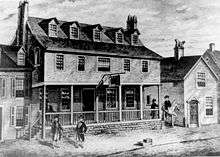Tun Tavern

Tun Tavern was a tavern and brewery in Philadelphia, Pennsylvania, which served as a founding or early meeting place for a number of notable groups. It is traditionally regarded as the site where what would become the United States Marine Corps held its first recruitment drive during the American Revolution.[1] It is also regarded as one of the "birthplaces of Masonic teachings in America."[2]
History
Founding
The tavern was erected in 1686 at the intersection of King (later called Water) Street and Tun Alley by settler Joshua Carpenter, brother of Samuel Carpenter, a Quaker merchant who made a fortune trading in Barbados. Joshua Carpenter built the Tun on the caraway that led to Carpenter's Wharf.[3] Tun Tavern was named for the Old English word "tun," meaning a barrel or keg of beer.[4] In the 1740s, a restaurant appelation, "Peggy Mullan's Red Hot Beef Steak Club" was added to the name of the tavern.[5]
Organizations founded in the Tavern
Tun Tavern hosted the first meetings of a number of organizations. In 1720, the first meetings of the St. George's Society (a charitable organization founded to assist needy Englishmen arriving in the new colony—predecessor of today's "Sons of the Society of St. George") were held there.[6] In 1732, the tavern hosted the first meetings of St. John's Lodge No. 1 of the Grand Lodge of the Masonic Temple. (The Masonic Temple of Philadelphia also recognizes Tun Tavern as the birthplace of Masonic teachings in America.) In 1747 Tun Tavern became the founding place of the St. Andrew's Society, which like the St. George's Society helped newly arrived Scottish.
Tun Tavern was a significant meeting place for other groups and individuals. In 1756 Benjamin Franklin used the inn as a recruitment gathering point for the Pennsylvania militia as it prepared to fight Native American uprisings. The tavern later hosted a meeting of George Washington, Thomas Jefferson, and the Continental Congress.
According to tradition, Tun Tavern was where the United States Marines held their first recruitment drive. On November 10, 1775, the Second Continental Congress commissioned the innkeeper and former Quaker Samuel Nicholas to raise two battalions of Marines in Philadelphia. The tavern’s manager, Robert Mullan, was the "chief Marine Recruiter." Though legend places its first recruiting post at Tun Tavern, historian Edwin Simmons surmises that it was more likely the Conestoga Waggon [sic], a tavern owned by the Nicholas family. The first Continental Marine company was composed of one hundred Rhode Islanders commanded by Captain Nicholas. Each year on November 10, U.S. Marines worldwide toast the memory of this colonial inn as the officially-acknowledged birthplace of their service branch. The earliest Marines were deployed aboard Continental Congress Navy vessels as sharpshooters because they were typically recruited as outstanding marksmen.[2]
The early history of Lodge No. 2 is the history of Freemasonry in Pennsylvania and in fact all of America. [7]
Present day
In 1781 (near the end of the American Revolution) Tun Tavern burned down. Its former structure stood at a location now occupied by Interstate 95, where it passes Penn's Landing. Tun Alley once existed between Walnut and Chestnut Streets east of Front Street. A commemorative marker on the east side of Front Street indicates the site, across from Sansom Walk.[8]
In homage to the likely 1775 Tun Tavern menu, the U.S. Marine Corps National Museum located in Quantico, Virginia contains a Tun Tavern-themed restaurant, whose lunch menu features beer and other fermented (alcoholic) beverages, peanut soup, and bread pudding, the non-alcoholic recipe of which remains a traditional staple among some U.S. Marine food services to this day.
See also
References
- ↑ "Tun Tavern History". Retrieved 2007-04-14.
- 1 2 Sturkey, Marion F. (2001) Tun Tavern (excerpt from "Warrior culture of the U.S. Marines") USMC Press. Retrieved 2008-09-02.
- ↑ Thompson, Peter (1999). Rum Punch & Revolution: Taverngoing & Public Life in Eighteenth-Century Philadelphia. Philadelphia: University of Pennsylvania Press. p. 28.
- ↑ Its name was occasionally written "Three Tons" and "Three Tuns" in the writings of J. Thomas Scharf and Thompson Westcott. 1884. History of Philadelphia, 1609-1884, Philadelphia: L. H. Everts & Co., Vol. I, pp. 203, 236. See also Harry Kyriakodis, Philadelphia's Lost Waterfront (The History Press, 2011) at 89-90, 95.
- ↑ The restaurant was called "Peg Mullen's celebrated beef-steak and oyster house" in John F. Watson and Willis P. Hazard. 1909. Annals of Philadelphia, and Pennsylvania, Philadelphia: Leary, Stuart & Co., Vol. I, pp. 394-395, 464-465, 469; "Peg" was also rendered "Pegg" in contemporary works, but not "Peggy."
- ↑ J. Thomas Scharf and Thompson Westcott. 1884. History of Philadelphia, 1609-1884, Philadelphia: L. H. Everts & Co., Vol. I, p. 233.
- ↑ http://lodge2.org/l2history.html
- ↑ "Tun Tavern Historical Marker". Retrieved 2010-11-08.
External links
Coordinates: 39°56′50″N 75°08′30″W / 39.9471°N 75.1417°W
